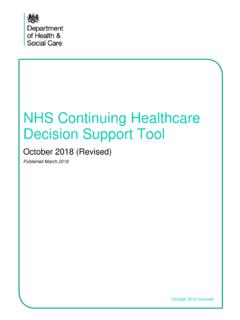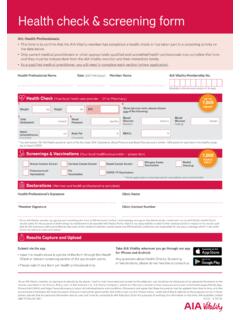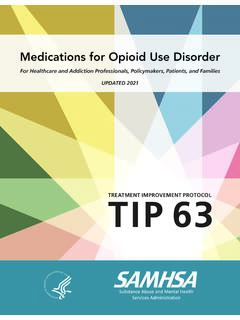Transcription of NHS Continuing Healthcare Checklist
1 NHS Continuing Healthcare Checklist October 2018 (Revised). Published March 2018. October 2018 (revised). DH ID box Title: NHS Continuing Healthcare Checklist Author: SCLGCP-SCP 25370. Document Purpose: Guidance Publication date: 1 March 2018. Target audience: Health and social care professionals Public Contact details: NHS Continuing Healthcare and NHS-funded Nursing Care team Department of Health and Social Care 39 Victoria Street London SW1H 0EU. You may re-use the text of this document (not including logos) free of charge in any format or medium, under the terms of the Open Government Licence.
2 To view this licence, visit Crown copyright 2016. Published to , in PDF format only. October 2018 (revised). NHS Continuing Healthcare Checklist What is the Checklist and why is it used? 1. The Checklist is a screening tool which can be used in a variety of settings to help practitioners identify individuals who may need a referral for a full assessment of eligibility for NHS Continuing Healthcare . 2. All staff who complete the Checklist should be familiar with the principles of the National Framework for Continuing Healthcare and NHS-funded Nursing Care and also be familiar with the Decision Support tool for NHS Continuing Healthcare .
3 3. The Checklist threshold at this stage of the process has intentionally been set low, in order to ensure that all those who require a full assessment of eligibility for NHS Continuing Healthcare have this opportunity. 4. There are two potential outcomes following completion of the Checklist : a negative Checklist , meaning the individual does not require a full assessment of eligibility and they are not eligible for NHS Continuing Healthcare ; or a positive Checklist meaning an individual now requires a full assessment of eligibility for NHS Continuing Healthcare .
4 It does not necessarily mean the individual is eligible for NHS Continuing Healthcare . Note: All these tools are available electronically (as Word documents) and pages or boxes can be expanded as necessary. It is important to note that these are national tools and the content should not be changed, added to or abbreviated in any way. However, CCGs may attach their logo and additional patient identification details if necessary ( adding NHS number, etc.). When should the Checklist be completed? 5. Where there may be need for NHS Continuing Healthcare , the Checklist should normally be completed.
5 6. There will be many situations where it is not necessary to complete the Checklist . See paragraphs 91 of the National Framework and page 7 below. 7. Screening and assessment of eligibility for NHS Continuing Healthcare should be at the right time and location for the individual and when the individual's ongoing needs are known. This may be in a variety of settings, although the full assessment of eligibility should normally take place when the individual is in a community setting, preferably their own home. The core underlying principle is that individuals should be supported to access and follow the process that is most suitable for their current and ongoing needs.
6 This will help practitioners to correctly identify individuals who require a full assessment of eligibility for NHS Continuing Healthcare . 8. To understand how NHS Continuing Healthcare interacts with hospital discharge, please refer to paragraphs 109-117 of the National Framework. 3. NHS Continuing Healthcare Checklist Who can complete the Checklist ? 9. The Checklist can be completed in by a variety of health and social care practitioners, so long as they have been trained in its use. What is the role of the individual in the screening process?
7 10. The individual should be given reasonable notice of the intention to undertake the Checklist and have the process explained to them. They should normally be given the opportunity to be present when the Checklist is completed, together with any representative they may have, so that they can contribute their views about their needs. 11. Where the individual concerned has capacity, their informed consent should be obtained before completion of the Checklist . It should be made explicit to the individual whether their consent is being sought specifically for the completion of the Checklist and the sharing of information for this, or for the full process, including the completion of the DST (where the Checklist is positive).
8 It is generally good practice to obtain consent that is valid for the whole process, bearing in mind that the individual must be told that they can withdraw their consent at any time. Please refer to paragraphs 72-73 of the National Framework which gives detailed guidance on what is required for consent to be valid. 12. If there is a concern that the individual may not have capacity to give consent to the assessment process or to the sharing of information, this should be determined in accordance with the Mental Capacity Act 2005 and the associated code of practice.
9 It may be necessary for best interests decisions to be made, bearing in mind the expectation that all who are potentially eligible for NHS Continuing Healthcare should have the opportunity to be considered for eligibility. Guidance on the application of the Mental Capacity Act in such situations is provided in paragraphs 74-81 of the National Framework. How should the Checklist be completed? 13. Completion of the Checklist is intended to be relatively quick and straightforward. It is not necessary to provide additional detailed evidence along with the completed Checklist .
10 14. Practitioners should compare the domain descriptors to the needs of the individual and select level A, B or C, as appropriate, choosing whichever most closely matches the individual. If the needs of the individual are the same or greater than anything in the A. column, then A' should be selected. Practitioners should briefly summarise the individual's needs which support the level chosen, recording references to evidence as appropriate. 15. A full assessment for NHS Continuing Healthcare is required if there are: two or more domains selected in column A.








